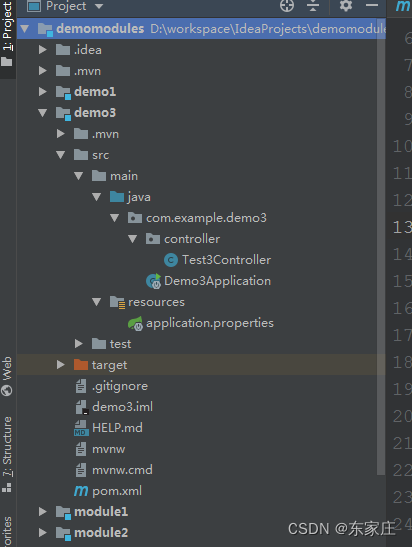springboot中各模块间实现bean之间互相调用(service以及自定义的bean)
1.建一个项目,两个module(注意项目和module都是创建类型如下图)2. 新建module1: demo1 ; module2: demo3,实现demo3 调用 demo1 的service建好如图:3.在demo3中引入demo1的依赖,demo3的pom文件中加入:<dependency><groupId>com.example</groupId>
·
1.建一个项目,两个module(注意项目和module都是创建类型如下图)

2. 新建module1: demo1 ; module2: demo3,实现demo3 调用 demo1 的service
建好如图:

3.在demo3中引入demo1的依赖,demo3的pom文件中加入:
<dependency>
<groupId>com.example</groupId>
<artifactId>demo1</artifactId>
<version>0.0.1-SNAPSHOT</version>
</dependency>4.demo1中新建service,实现调用。
package com.example.demo1.controller;
import com.example.demo1.configure.TesttConfigure;
import com.example.demo1.service.TestService;
import org.springframework.beans.factory.annotation.Autowired;
import org.springframework.web.bind.annotation.GetMapping;
import org.springframework.web.bind.annotation.RequestMapping;
import org.springframework.web.bind.annotation.RestController;
@RestController
@RequestMapping("/demo1")
public class TestController {
@Autowired
private TestService testService;
@Autowired
private TesttConfigure testtConfigure;
@GetMapping("/test1")
public String test1(){
System.out.println(testtConfigure.ttt());
return testtConfigure.ttt()+testService.testService();
}
}
5.demo1中成功调用后,demo3中直接引入依赖就可以
package com.example.demo3.controller;
import com.example.demo1.configure.TesttConfigure;
import com.example.demo1.service.TestService;
import org.springframework.beans.factory.annotation.Autowired;
import org.springframework.web.bind.annotation.RequestMapping;
import org.springframework.web.bind.annotation.RestController;
@RestController
public class Test3Controller {
@Autowired
private TestService testService;
@Autowired
private TesttConfigure testtConfigure;
@RequestMapping("/test3")
public String test3(){
String str = testService.testService()+"------test3-------"+testtConfigure.ttt();
return str;
}
}
6.demo3实现调用demo1中自定义的bean。
demo1中自定义bean,启动类中配置,实现能正常能访问
自定义配置类:
package com.example.demo1.configure;
import org.springframework.context.annotation.Bean;
import org.springframework.context.annotation.Configuration;
@Configuration
public class TesttConfigure {
@Bean(name = "Test1")
public String ttt(){
return "----tttttt-----";
}
}
demo1中启动类设置:
package com.example.demo1;
import org.springframework.boot.SpringApplication;
import org.springframework.boot.autoconfigure.SpringBootApplication;
import org.springframework.context.annotation.ComponentScan;
@SpringBootApplication
@ComponentScan(basePackages = "com.example.demo1")
public class Demo1Application {
public static void main(String[] args) {
SpringApplication.run(Demo1Application.class, args);
}
}
controller层注入,实现调用:
package com.example.demo1.controller;
import com.example.demo1.configure.TesttConfigure;
import com.example.demo1.service.TestService;
import org.springframework.beans.factory.annotation.Autowired;
import org.springframework.web.bind.annotation.GetMapping;
import org.springframework.web.bind.annotation.RequestMapping;
import org.springframework.web.bind.annotation.RestController;
@RestController
@RequestMapping("/demo1")
public class TestController {
@Autowired
private TestService testService;
@Autowired
private TesttConfigure testtConfigure;
@GetMapping("/test1")
public String test1(){
System.out.println(testtConfigure.ttt());
return testtConfigure.ttt()+testService.testService();
}
}
这里的 testtConfigure 是自定义配置类。
demo1能访问成功后,demo3直接注入就可以,和上面注入demo1的service一样。
更多推荐
 已为社区贡献2条内容
已为社区贡献2条内容









所有评论(0)